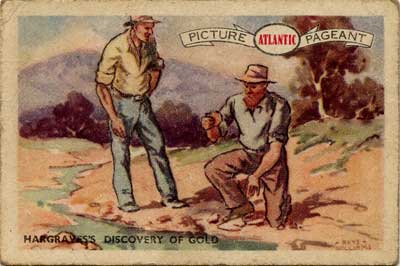CHILDHOOD COLLECTING:
Stamp collecting, free books and collector cards encourage an early interest in Australian History.
 This week I came across my old stamp album. I received it for my fifth birthday from my parents and brother. It was the Globe Stamp Album and on the cover it claims it ìcould hold approximately 4000 stampsî. The first page is devoted to Australian stamps. My father was an avid stamp collector and soon set me up with the start of my collection.
This week I came across my old stamp album. I received it for my fifth birthday from my parents and brother. It was the Globe Stamp Album and on the cover it claims it ìcould hold approximately 4000 stampsî. The first page is devoted to Australian stamps. My father was an avid stamp collector and soon set me up with the start of my collection.
I learnt how to attach a glued hinge to my stamps and position them carefully on the page. I grouped my mint and used stamps. I could use tweezers to handle the stamps so as not to damage them. As I grew older I was allowed to look in the Stanley Gibson catalogues my father had. These cumbersome, reference books made me feel very important. In them I found pictures of my stamps, their date of issue, what variety of colours they came in, and their "catalogue value". My stamp collecting taught me the names of exotic places around the world. Zanzibar was a favourite which rolled off my tongue so effortlessly. I liked the pretty coloured stamps from Hungary but soon discovered that they had "little value". Lessons were being learnt, at a young age, about "not judging books by their covers".
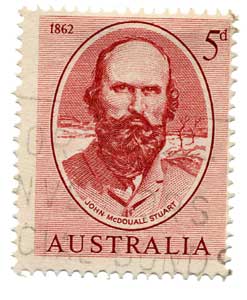 Sometimes the most uninteresting of stamps seemed to possess immense value. My father had some of these. Any stamps discarded by father or brother because they were damaged were given to me. I called these "my tornies". The word philately breezed into my vocabulary.
My Australian stamps drew my attention to Australia's history. For example, my father gave me an old one and a half penny red of explorer Charles Sturt, issued in 1930. I had a two penny red of Governor Phillip landing at Sydney Cove, issued in 1937. In my collection were three in the Sir Thomas Mitchell series, issued in 1946.
Sometimes the most uninteresting of stamps seemed to possess immense value. My father had some of these. Any stamps discarded by father or brother because they were damaged were given to me. I called these "my tornies". The word philately breezed into my vocabulary.
My Australian stamps drew my attention to Australia's history. For example, my father gave me an old one and a half penny red of explorer Charles Sturt, issued in 1930. I had a two penny red of Governor Phillip landing at Sydney Cove, issued in 1937. In my collection were three in the Sir Thomas Mitchell series, issued in 1946.
Considering the immense distances covered by Mitchell in his role as Surveyor General, I do not think he had ever spent as long in one place as he did in my little stamp album. From a five penny red, the determined explorer John McDouall Stuart, who met with success on his third attempt to cross Australia from South to North, looked at me with a fixed, stern gaze as if I had done something terrible to him. I was going to say he looked a bit unhinged but I am sure he wasnít, for I had already seen to that! In 1963 I received in the mail one of my very favourite, first day covers celebrating the one hundred and fiftieth anniversary of the Blue Mountains crossing. It was usually my mother who would address envelopes to my brother and me and send them.

Sometimes they were specially printed ones for the occasion. They would bear the new stamp, post marked on its first day of issue. It was most exciting to receive these first day covers celebrating events drawn from Australiaís past. From an early age, stamp collecting nurtured my interest in my country's history. I will always be grateful to my parents for that.
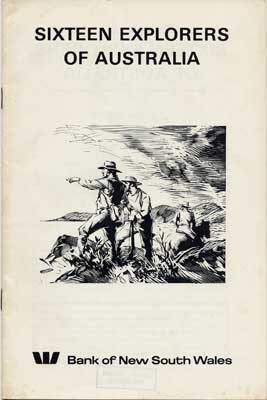
The Aboriginal people, the early settlers, the explorers, the statesmen, the soldiers, the royal family - they were all there and more. Even though I am now a bit of a "hot and cold" collector, I still value my stamp collection and enjoy perusing it. When I was a school boy, the Bank of New South Wales (now Westpac) used to give school children a booklet entitled Sixteen Explorers of Australia for free. It was published in 1956. The first edition, which came out in 1951, was originally called Fourteen Explorers of Australia. The booklet contained black lined portraits of each colonial explorer, a brief account of their achievements and a map of their journeys.
I have never "banked Westpac" but I am grateful that someone in their ranks had the notion to produce this useful, little book. In its pages I learnt of the tragic exploits of Robert O'Hara Burke and William John Wills and also that of Ludwig Leichhardt. Another useful, little book that contained a wealth of information about Australian history was Discovery. From memory, it was sent to you freely on request by Cottee's, makers of jams, conserves and soft drinks. Back then the companyís name was proudly preceded by the words ìthe Australian Company ofî Cottee's. Nowadays this company is part of Cadbury Schweppes, a foreign owned public company - the times, they are a-changing!
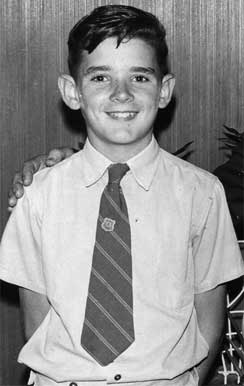 In my day when your parents bought your new school short pants and shirt, you could be pretty sure they had the ìStaminaî brand on them. We used to get attired in our new Stamina clothing at Crows Nest. A packet of "Australian Men of Stamina" would be found inside the pocket. Apparently these card sets began being issued in the mid 1940s. Faces from our countryís past stared at you as you eagerly opened and began flicking through the packet. Where the Women of Stamina were hiding is anyoneís guess. No indigenous people of Stamina were there either. Not that these considerations even entered our young minds in those days.
But there were exceptions that did. As far as I can remember, these cards never considered Burke and Wills or Leichhardt to be "Men of Stamina". Perhaps their stories were too sad or someone deemed them unfitting a certain stereotype of the day.
In my day when your parents bought your new school short pants and shirt, you could be pretty sure they had the ìStaminaî brand on them. We used to get attired in our new Stamina clothing at Crows Nest. A packet of "Australian Men of Stamina" would be found inside the pocket. Apparently these card sets began being issued in the mid 1940s. Faces from our countryís past stared at you as you eagerly opened and began flicking through the packet. Where the Women of Stamina were hiding is anyoneís guess. No indigenous people of Stamina were there either. Not that these considerations even entered our young minds in those days.
But there were exceptions that did. As far as I can remember, these cards never considered Burke and Wills or Leichhardt to be "Men of Stamina". Perhaps their stories were too sad or someone deemed them unfitting a certain stereotype of the day.
It is a mystery to me. For one thing, their stories helped shape my understanding of the unforgiving nature and vastness of this continent. In 1958 the collector card Australian Historical Series, issued by Atlantic petrol stations, welcomed them into the fold. These cards were attractive, watercolour paintings by the artist Rhys Williams, with information on the back. It is interesting to note that it was not until 1983 that Leichhardt was given his own postage stamp. Burke and Wills also shared their first stamp that same year.
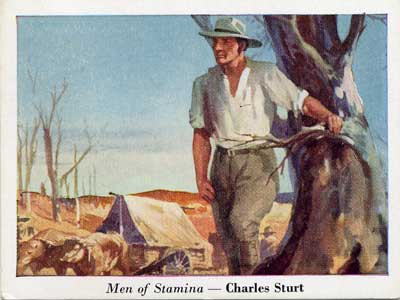 As an impressionable youngster growing up in the 1950s, I look back on my stamps, booklets and cards with fondness and gratitude. They led me down a path of interest, off which I have fortunately never stepped.
As an impressionable youngster growing up in the 1950s, I look back on my stamps, booklets and cards with fondness and gratitude. They led me down a path of interest, off which I have fortunately never stepped.
© Jim Low 25 April 2006
